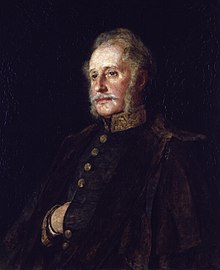Brian Houghton Hodgson
Brian Houghton Hodgson (born February 1, 1800 in Lower Beech , Prestbury , Cheshire , † May 23, 1894 in Alderley , Gloucestershire ) was a British ethnologist , orientalist and naturalist . He spent several years as the British envoy in Kathmandu , Nepal .
life and career
Hodgson studied at the British East India Company ’s Haileybury College in 1816/17 , where he earned a medal in classicism as well as prizes in Bengali and political economy . He then sailed to Calcutta to take a post as an administrator at the British East India Company. He also studied at Fort William College . So that he could recover from illness, he was sent to Kumaon in 1818 as the second ambassador . In Kathmandu he became second colonial administrator after Edward Gardner in the government of Nepal in 1820 . Since he found little to do there in this position, he returned to Calcutta, where he was appointed second foreign minister. However, he soon fell ill there again because of the heat and the high humidity . So in 1824 he was sent back to Nepal, where he was promoted to managing director in 1829 and to British envoy to Nepal in 1833. At the beginning of his tenure as colonial administrator he was repeatedly in conflict with the Rana Maharajas for several years , which he ended in 1839 with a treaty that satisfied both sides. However, the Viceroy (Governor General) of India , Lord Ellenborough (1790–1871) changed the clauses of the treaty that Hodgson placed over the Nepalese government in order to prevent possible unrest in Nepal during the conflict in Afghanistan . Hodgson disregarded his instructions and justified this with his thorough knowledge of the situation.
Further studies
In Nepal, Hodgson lived with a Muslim woman in a shared apartment and had two children with her. There he studied the Nepalese people and published over 140 writings on their languages, literature and their religion , Buddhism . He also studied the flora and fauna of this kingdom and collected a variety of mammals , which he later donated to the British Museum in London . There he discovered a new antelope species among 39 other mammal species , which was named after him: the Tibetan antelope ( Pantholops hodgsonii ). Furthermore, he discovered 124 previously unknown bird species , of which he was the first to describe 79. He himself also kept some wild animals in captivity so that he could study them better. His collections, exhibited in the British Museum in 1843 and 1858, comprised over 10,500 different species . In addition, the collection included thousands of drawings and color sketches of animals native to India. These were made by Indian and Nepalese artists such as Rajman Singh or Tursmoney Chitterkar under his guidance. Some of these works are now owned by the Zoological Society of London .
Retirement
Hodgson resigned as British colonial administrator in 1843 and returned to Britain for a brief period. However, in the following year he moved to Darjeeling and continued his research on the north Indian peoples. On another brief visit to Great Britain, he married Anne South . Because her health was not doing well in Darjeeling either, they settled in Great Britain in 1858, in the Cotswolds . In 1868 his wife died, two years later he married Susan Townsend and died on May 23, 1894 in Alderley Grange, Gloucestershire.
Honors
After he left 88 manuscripts in Sanskrit at his own expense to the Collège de France in Paris , he became a member of the French Legion of Honor in 1838 and received a gold medal for it. In the same year the Société asiatique presented him with another gold medal and he became an honorary member of the Institut de France . Celebrated in France and Germany for his research, his services were hardly recognized in his home country. With reluctance, he was in 1877 Fellow of the Royal Society , and until his 89th year of life gave him the Oxford University the title of Honorary Doctor .
Taxonomy
In honor of Hodgson, the pumpkin genus Hodgsonia as well as the Tschiru and the Tibet Argali were named.
Works
- Miscellaneous Essays relating to Indian Subjects. Truebner, London 1880.
- Essays on the languages, literature, and religion of Nepál and Tibet. Truebner, London 1874.
- Comparative vocabulary of the languages of the broken tribes of Népál. Calcutta 1859.
- Papers relative to the colonization, commerce, physical geography, & c. ... Calcutta 1857.
- Route of two Nepalese Embassies to Pekin with remarks on the water-shed and plateau of Tibet. Hodgson, Darjeeling 1856.
- Route from Kathmandu, the capital of Nepal, to Darjeeling in Sikim, interspersed with remarks on the people and country. Calcutta 1848.
- Essay the first. Thomas, Calcutta 1847.
- Preeminence of the vernaculars. Serampore 1847.
- Catalog of Nipalese birds between 1824 and 1844. Calcutta 1844.
- Illustrations of the literature and religion of the Buddhists. Serampore, 1841.
literature
- Krishna L. Pradhan: Brian Hodgson at the Kathmandu residency. Spectrum & United, Guwahati, Delhi 2001, ISBN 81-87502-15-0 .
- Mark Cocker, Carol Inskipp: A Himalayan ornithologist. Oxford 1988, ISBN 0-19-857619-6 .
- William Wilson Hunter : Life of Brian Houghton Hodgson, British resident at the court of Nepal ... Murray, London 1896.
- David M. Waterhouse (Ed.): The origins of Himalayan studies. Brian Houghton Hodgson in Nepal and Darjeeling 1820-1858. London 2004, ISBN 0-415-31215-9 .
Web links
- Brian Houghton Hodgson , entry in the Encyclopædia Britannica 1911 (English)
| personal data | |
|---|---|
| SURNAME | Hodgson, Brian Houghton |
| BRIEF DESCRIPTION | British colonial administrator of Nepal, ethnologist, orientalist and naturalist |
| DATE OF BIRTH | February 1, 1800 |
| PLACE OF BIRTH | Lower Beech , Prestbury, Cheshire |
| DATE OF DEATH | May 23, 1894 |
| Place of death | Alderley Grange , Gloucestershire |
